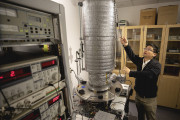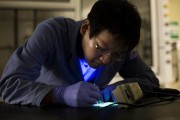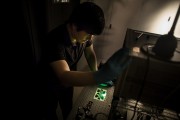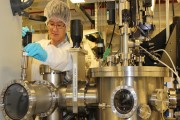 2019-02-15
2019-02-15
Researchers found a new method of photonic cooling by running LED with electrodes reversed. Researchers believe that this approach could improve cooling technology for future microprocessors, which will include various transistors in a small space that current methods cannot remove heat quickly enough. The finding was published on Nature on February 13 by a research team at the University of Michigan.
Linxiao Zhu, the lead author on the research article, explained, “Usually for thermal radiation, the intensity only depends on temperature, but we actually have an additio...
Continue reading →
 2014-07-18
2014-07-18
Researchers at the University of Michigan have taken a major stride toward perfectly efficient lighting that is also relatively inexpensive and simple to make. The same material can also reveal the presence of water by changing color.
Continue reading →
 2014-06-24
2014-06-24
The most common kind of light bulb in the United States—the incandescent—is only about 5 percent efficient. The phosphorescent organic light-emitting diode, on the other hand, makes light out of 100 percent of the electricity that goes into it.
Continue reading →
 1970-01-01
1970-01-01
Researchers at the University of Michigan have discovered a way to get 50% more light out of organic light emitting diodes (OLEDs), bringing them one step closer to more widespread adoption as a general lighting source, while increasing their value in displays.
Continue reading →
 2019-02-15
2019-02-15
 2014-07-18
2014-07-18
 2014-06-24
2014-06-24
 1970-01-01
1970-01-01